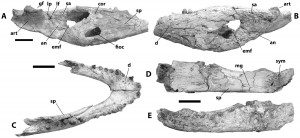
Mandibular remains of Crocodylus anthropophagus. Brochu CA, Njau J, Blumenschine RJ, Densmore LD (201 0) A New Horned Crocodile from the Plio-Pleistocene Hominid Sites at Olduvai Gorge, Tanzania. PLoS ONE 5(2): e9333
The Guardian, in article dated February 27 revealed that Tanzanian and American scientists have finally identified the remains of a 7.5-metre-long man-eating crocodile in the Olduvai Gorge. They estimate its age to be 1.8 million years which could make it the largest predator ancient humans in the region could ever have encountered.
Dr Fidelis Masao, a researcher in the Gorge, said that the remains would be returned to Tanzania some three years from now after they have been analysed in America, “unlike our dinosaur skeletons that were taken to Germany but have not been returned. The dinosaurs were not brought back mainly following legal complications because Tanzania was under German colonial rule when they were discovered. The researcher explained that the discovery was proof that in the environment of those ancient times such creatures could survive, although that might be very difficult now.
Chris Brochu, a vertebrate palaeontologist at the University of Iowa was quoted as saying that he would not guarantee that the crocodiles in question killed ancient humans “only that they were certainly biting them”. Ancient hominid bones discovered by Mary and Louis Leakey in the same sediments bear distinct bite marks likely to have been inflicted by large crocodiles. Yet, most researchers have assumed that the gashes were delivered by the same species of crocodiles that prowls the banks of the Nile today.
This is not so claims Brochu, who re-analysed numerous incomplete fossils, the most recent of which was unearthed in 2007 by among others Jackson Njau of the Natural History Museum in Arusha. Though roughly the same size as the reptilian denizens of the Nile, the Olduvai crocodiles had thinner, more flared snouts and large horns more characteristic of Madagascan crocodiles that went extinct in the past few thousand years. “The discovery of C. anthropophagus points to far more diversity in African crocodiles in the past 2.5 million years than was thought,” argues Brochu. He says his team has not found many fossils belonging to C. anthropophagus, but none is complete, “so it’s impossible to determine its precise relationship to the modern Nile crocodiles. But, Brochu has little doubt that C. anthropophagus threatened the ancient hominids who called Olduvai Gorge home. According to the palaeontologists, larger crocodiles would have been capable of consuming hominids completely, leaving no trace.
